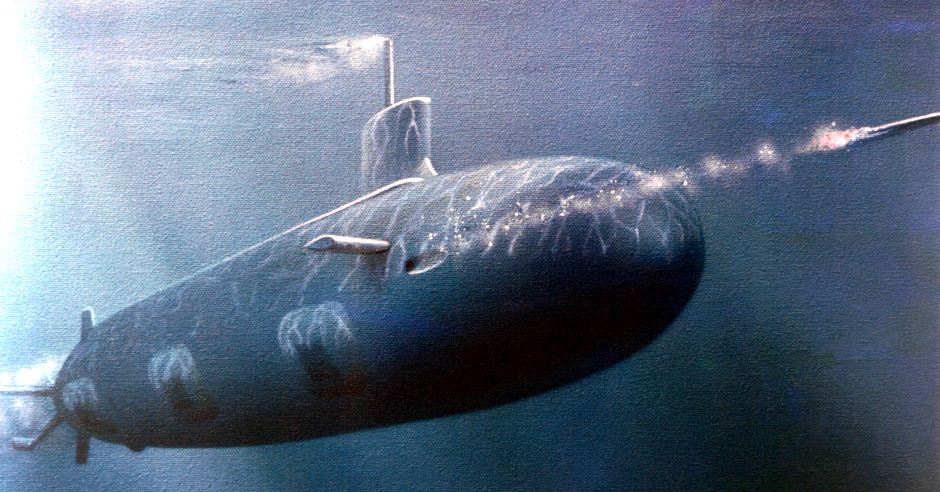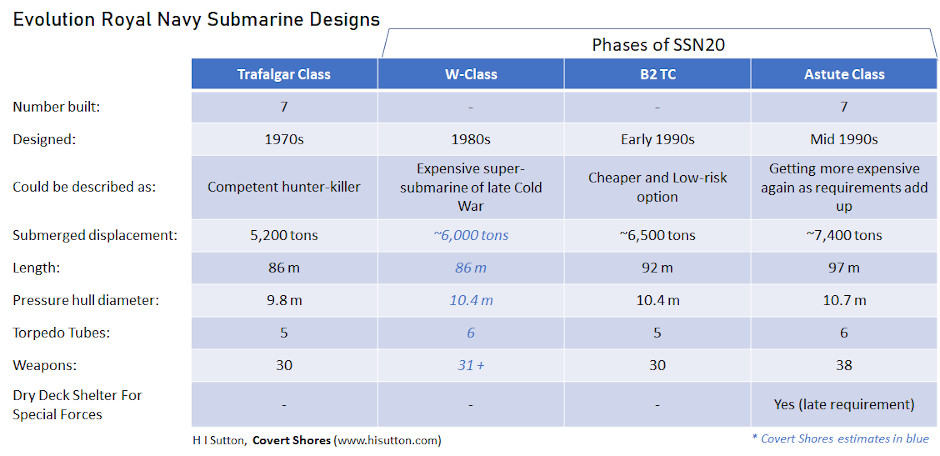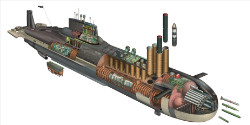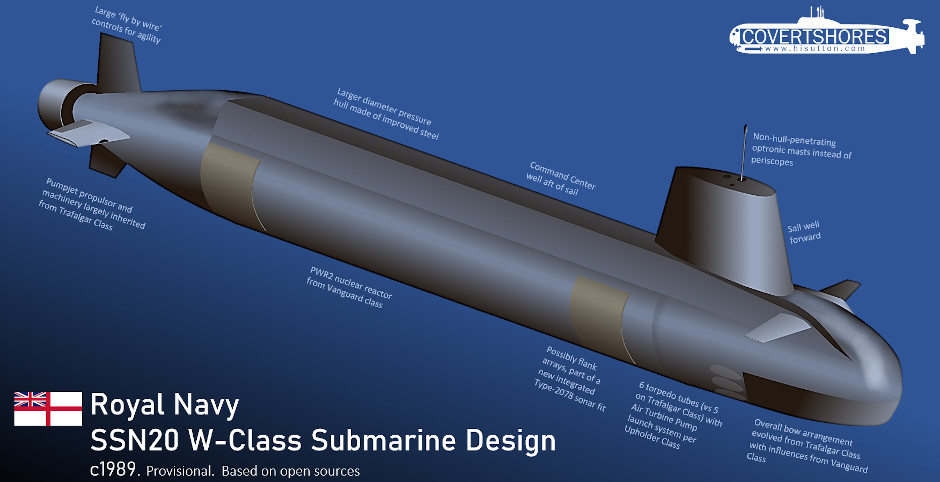The Astute Journey: Unbuilt British Submarine Designs After The Trafalgar Class
 Today the Astute is one of the most impressive, and recognizable, attack submarines afloat. But how did it come about? This article will lay out the unbuilt submarine designs which plot the story from the Trafalgar Class to the Astute class.
Today the Astute is one of the most impressive, and recognizable, attack submarines afloat. But how did it come about? This article will lay out the unbuilt submarine designs which plot the story from the Trafalgar Class to the Astute class.
SSN20 / W-Class
In the 1980s, at the height of the Cold War, the Royal Navy wanted a new nuclear-powered attack submarine (SSN) to succeed the successful Trafalgar Class. Facing ever quieter Soviet submarines (ALFA, VICTOR-III, SIERRA, AKULA,..), the requirements moved in a similar direction to the U.S. Navy’s Seawolf Class.
The design was called SSN20. This fitted well with the contemporary U.S. Navy SSN-21 program, now known as the Seawolf class. But it is coincidence as the SSN20 refers to the first in class as being the 20th nuclear powered attack submarine. SSN-21 refers to the 21st century.

SSN20 was contemporary to the US Navy's SSN-21program, now known as Seawolf Class. They were designed to meet similar challenges. As this 1980s artwork shows, the Seawolf Class has a very large diameter pressure hull. SSN20 was to be larger than the Trafalgar, but much smaller than Seawolf.
The overall combat capability was to be a major upgrade to the Trafalgar class, with a new integrated sonar suite and a new combat system. The weapons were to be more effective. This implies the Spearfish torpedo, and also an Air Turbine Pump system for launching the weapons. The latter had been developed for the Upholder Class diesel-electric boats.
A new nuclear reactor was also planned; the PWR2 then being developed for the Vanguard class. This necessitated a larger diameter pressure hull which was to be made out of a new type of steel for greater diving depth. The control surfaces were to provide improved agility. This likely meant being independently controllable and ‘fly by wire’.
Get The essential guide to World Submarines
This Covert Shores Recognition Guide Covers over 80 classes of submarines including all types currently in service with World Navies.Check it out on Amazon
The class was given the letter ‘W’, a Royal Navy tradition where all the boats in the class would have names started with the same letter. This had been applied since the 1930s and had, by the late Cold war, developed into a sequential walk through the alphabet. ‘W’ was the natural follow to the ‘V’ class ballistic missile submarines (SSBNs).
We can speculate that the lead ship might have been named HMS Warspite. This is a favorite ship name in the Royal Navy with a proud tradition. There was an HMS Warspite already in service when the class was named, but that was soon to be decommissioned. Other historical Royal Navy ship names beginning with W include Walrus, Wasp, Watchful, Whirlwind, Wild Boar, Wizard, Wolf, * and Wolverine*. Personally I like the “Wizard Class”, it seems very fitting.
Cold War Royal Navy submarine classes, letter sequence:
A - Amphion Class. World War Two submarine design used until 1970s
E - Explorer Class. Experimental AIP submarines
P - Porpoise Class. Early Cold War conventionally powered submarine
O – Oberon Class. Improvement of the Porpoise Class. Main conventionally powered class during Cold War
D - HMS Dreadnought. First nuclear submarine
V / W - Valiant Class. Follow-on to Dreadnought. Only two submarines built with W used for the second boat, HMS Warspite.
C - Churchill Class. Also categorized under V for Valiant follow on.
R - Resolution Class. The Royal Navy's first nuclear powered ballistic missile submarines
S - Swiftsure Class. Much improved nuclear-powered attack submarine
T - Trafalgar Class. Follow-on to Swiftsure Class
U – Upholder Class. Late Cold War conventionally powered class to succeed Oberon
V - Vanguard Class. Late Cold War ballistic missile submarine.
W - intended successor to Trafalgar Class
A - Astute Class
SSN(R) – current program name for next Royal navy SSN.
Note that this tradition will be broken by the new Dreadnought Class ballistic missile submarines which will have a mix of first letters: Dreadnought, Valiant, Warspite, and King George VI.

Batch 2 Trafalgar Class: The curse of the peace dividend
The USSR dissolved on December 25/26 1991. It was seen as a Christmas present by many. Defense cuts ensued; the so-called peace dividend. And it led to changes in the SSN20 submarine program. The formidable Soviet submarines which it was intended to counter were now no longer adversaries, and were themselves being cut. It was a dark time for submarine services on both sides of the Cold War.
THE book on Special Forces subs Covert Shores 2nd Edition. A world history of naval Special Forces, their missions and their specialist vehicles. SEALs, SBS, COMSUBIN, Sh-13, Spetsnaz, Kampfschwimmers, Commando Hubert, 4RR and many more.
Check it out on Amazon
Other Royal Navy submarine programs also suffered. The Upholder Class was cancelled and the first four boats were retired (later sold to Canada as the Victoria Class). From now on the Royal Navy Submarine service was to be all-nuclear.
For SSN20 the emphasis was now on cost reduction, risk reduction and political optics. A hint was in the new preferred name, B2 TC which means Batch 2 Trafalgar Class. It was to be downplayed to sound like another iteration of an existing class. This was half true as the design went back to basics. But at the same time technology had moved on since the Trafalgars were built and the reactor and hull construction remained from the W-Class.
B2-TC looked a lot like an enlarged Trafalgar Class. It was still an impressive design, but much less of a step forward.
From the perspective of submarine development the peace dividend was a curse. The cancellation of projects, reorganizations between MoD (Ministry of Defense) and industry, and related job cuts, led to breaks in the design and production. This in turn led to serious skills shortages. Building the Astute Class, as SSN20 became, was more difficult than it ought to have been. The lesson here is that submarine building needs constant work to prevent a knowledge loss.
Over time the requirements mounted again and slowly (there doesn’t seem to have been a huge rush), it evolved into a much larger, and more expensive, submarine. The Astute Class are very impressive, and that maybe is for a separate article.
Related articles (Full index of popular Covert Shores articles)

 Trafalgar Class w/Cutaway
Trafalgar Class w/Cutaway

 British SSN(R) next generation Royal Navy SSN
British SSN(R) next generation Royal Navy SSN

 USS Jimmy Carter (SSN-23) Special Mission submarine
USS Jimmy Carter (SSN-23) Special Mission submarine
 TYPHOON Class SSBN. w/Cutaway
TYPHOON Class SSBN. w/Cutaway

 Project 885 'YASEN' (Severodvinsk Class) SSGN. w/Cutaway
Project 885 'YASEN' (Severodvinsk Class) SSGN. w/Cutaway

 Project 955A 'BOREI-A' Ballistic Missile Submarine. w/Cutaway
Project 955A 'BOREI-A' Ballistic Missile Submarine. w/Cutaway






